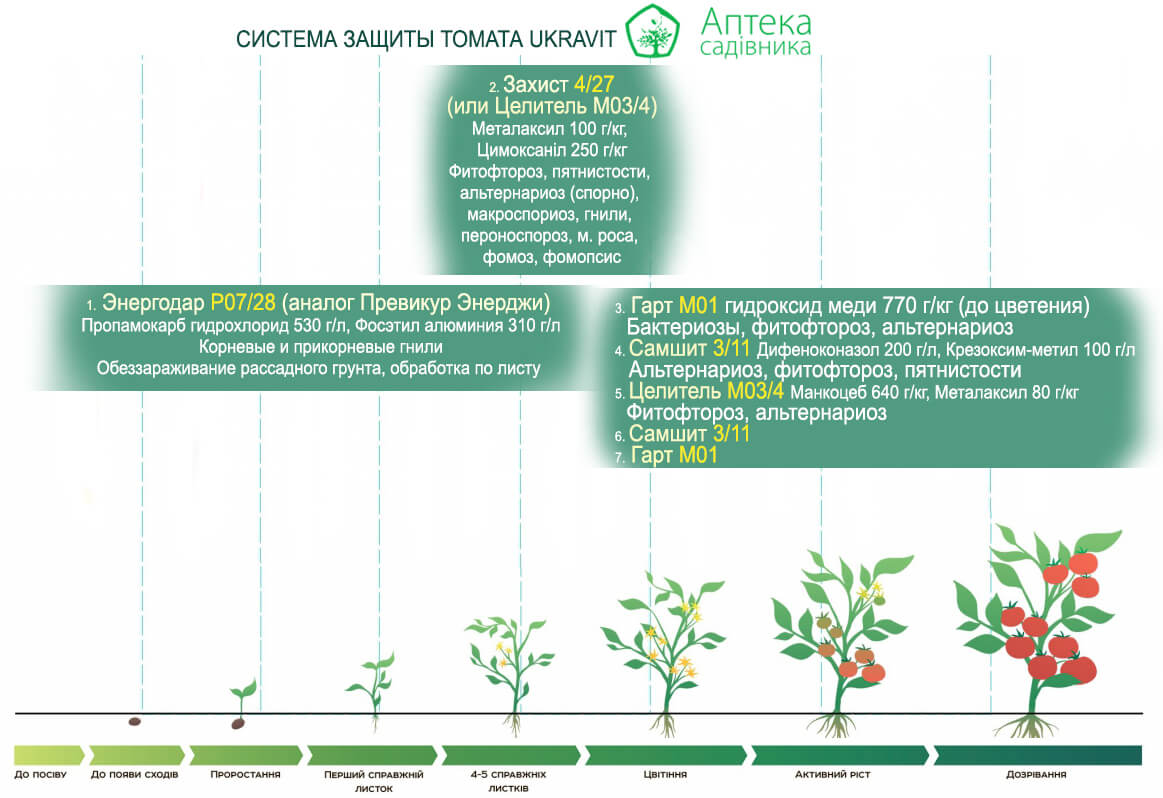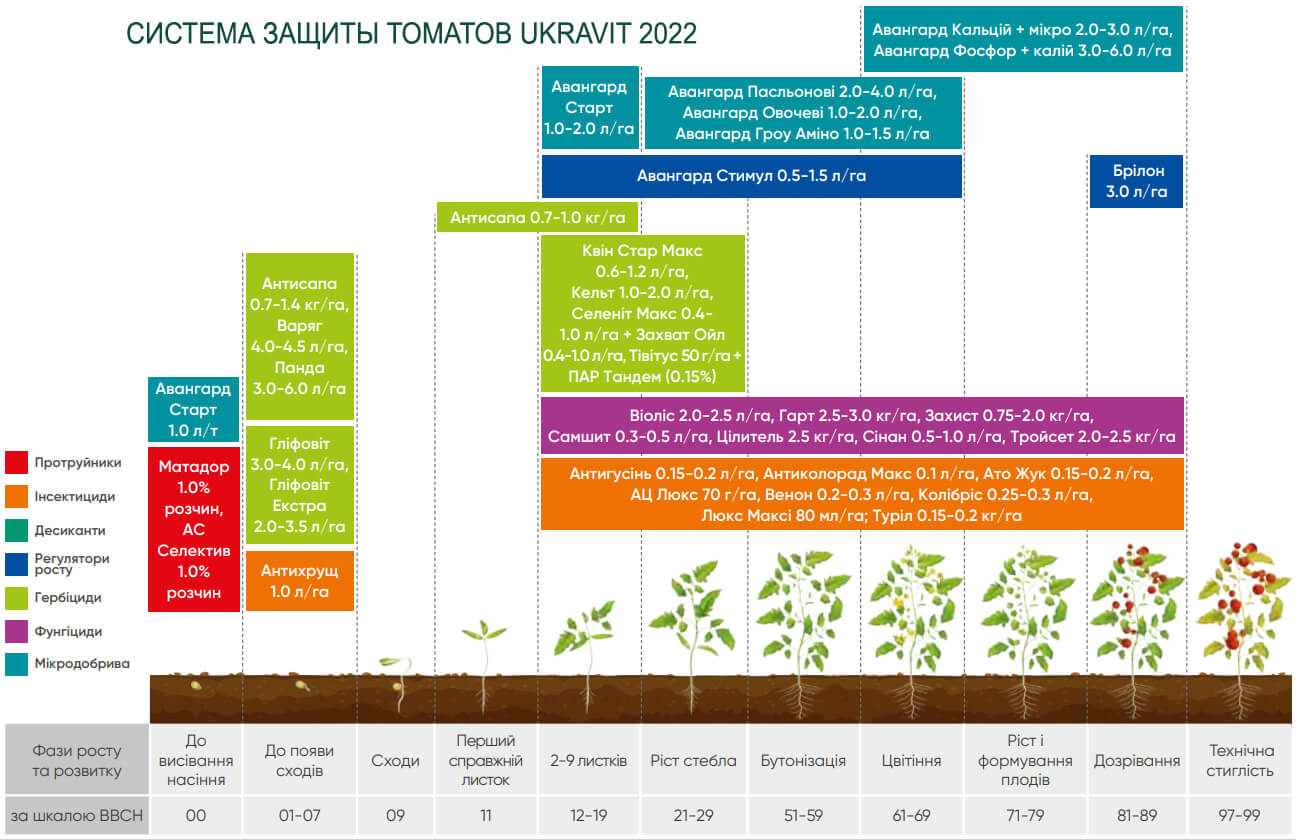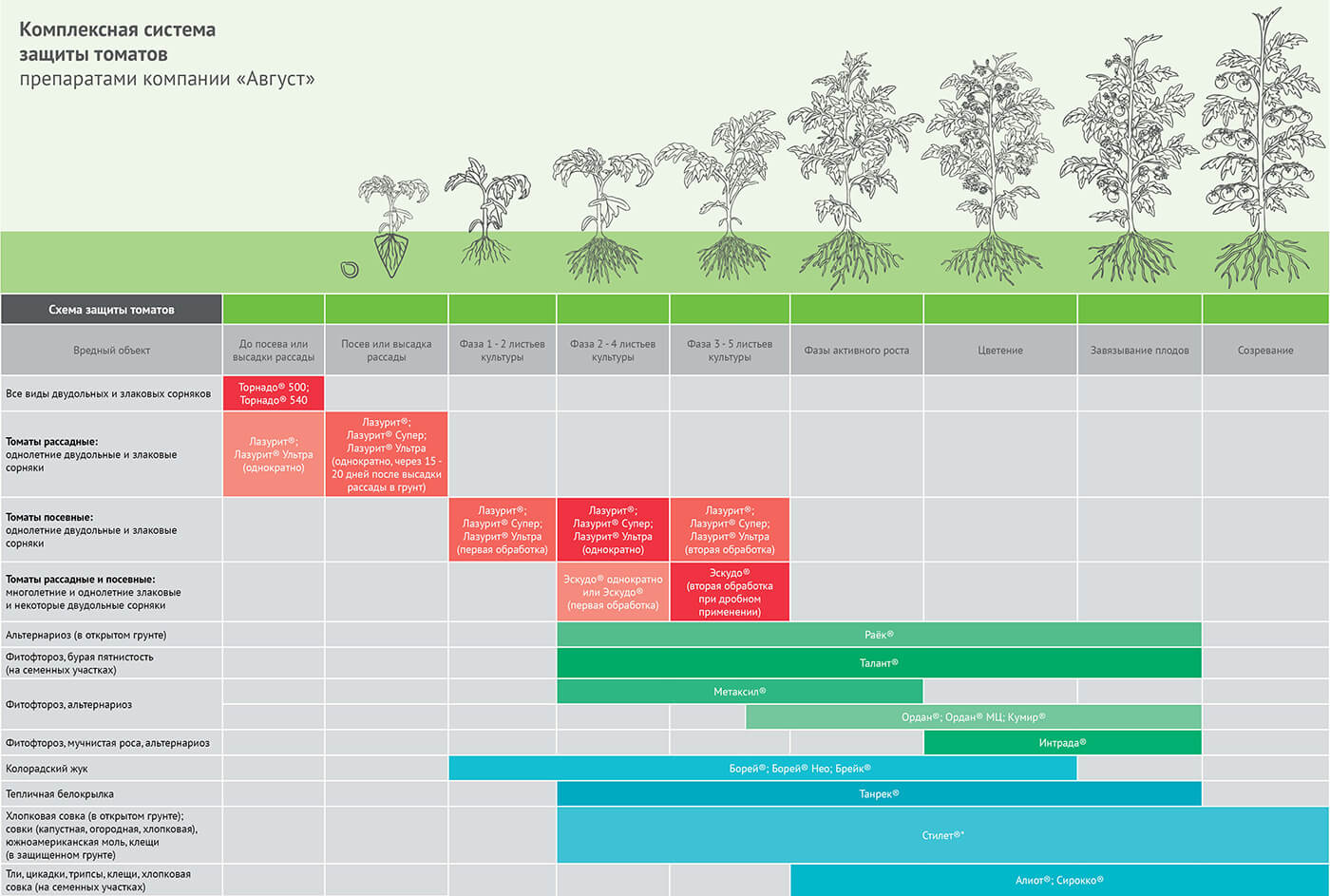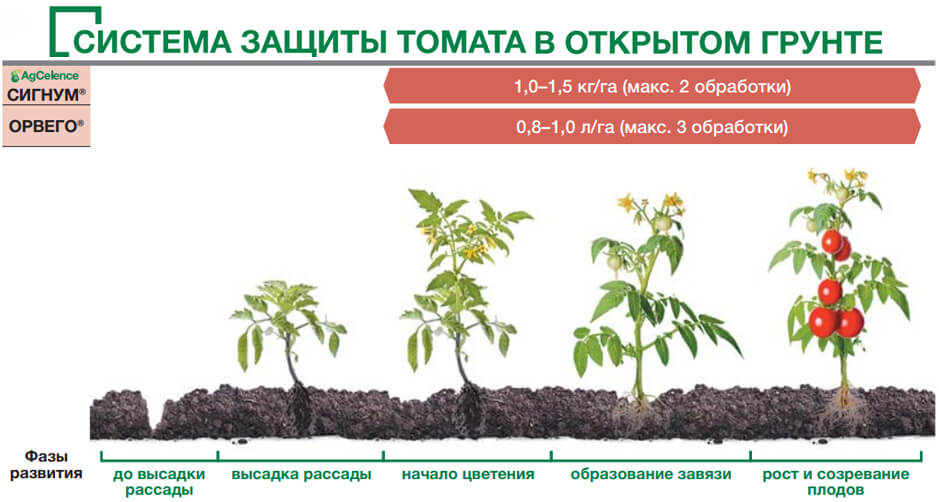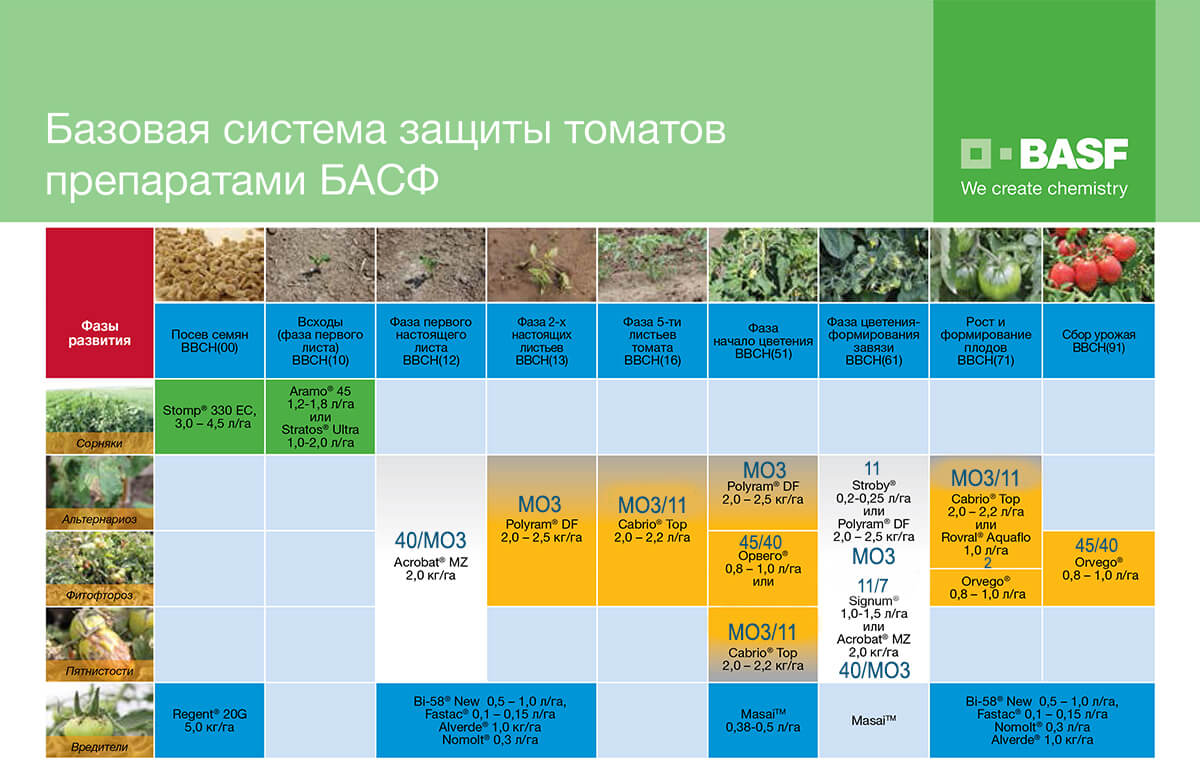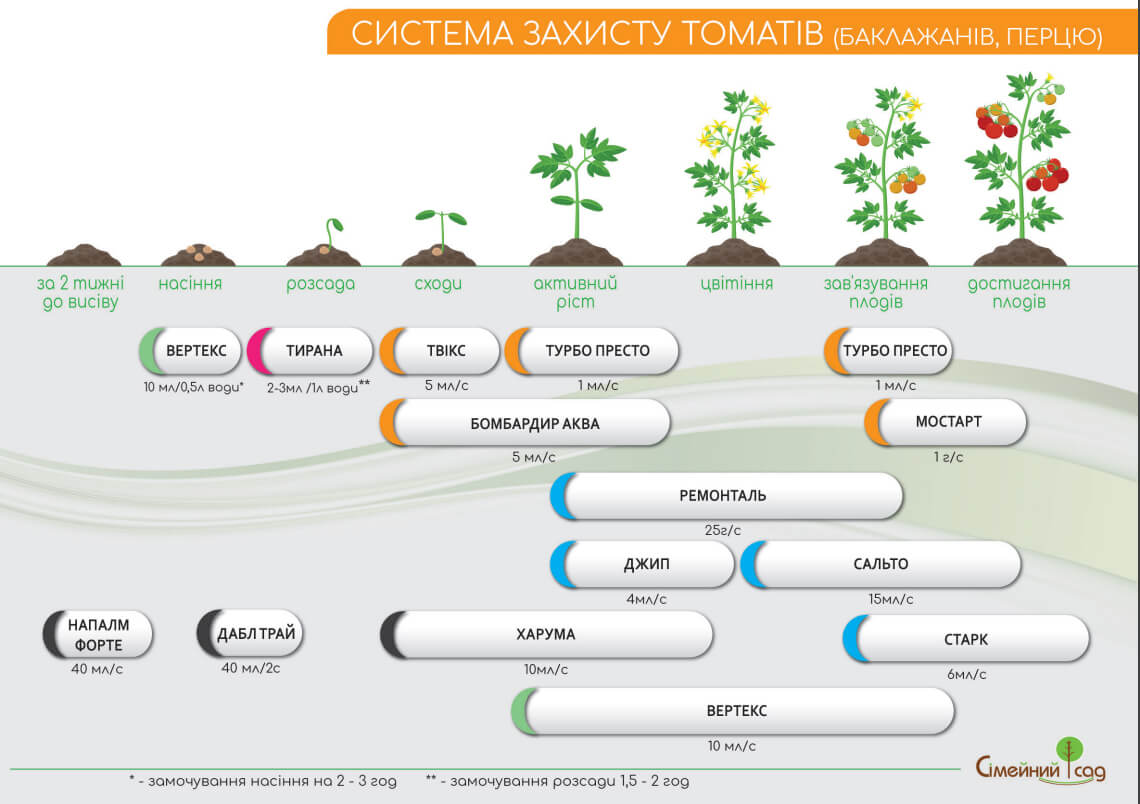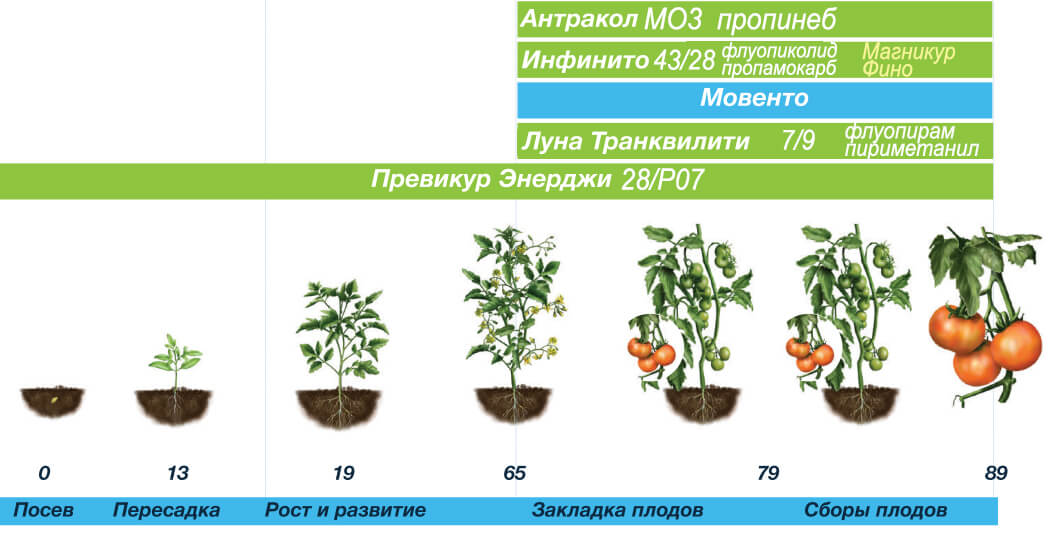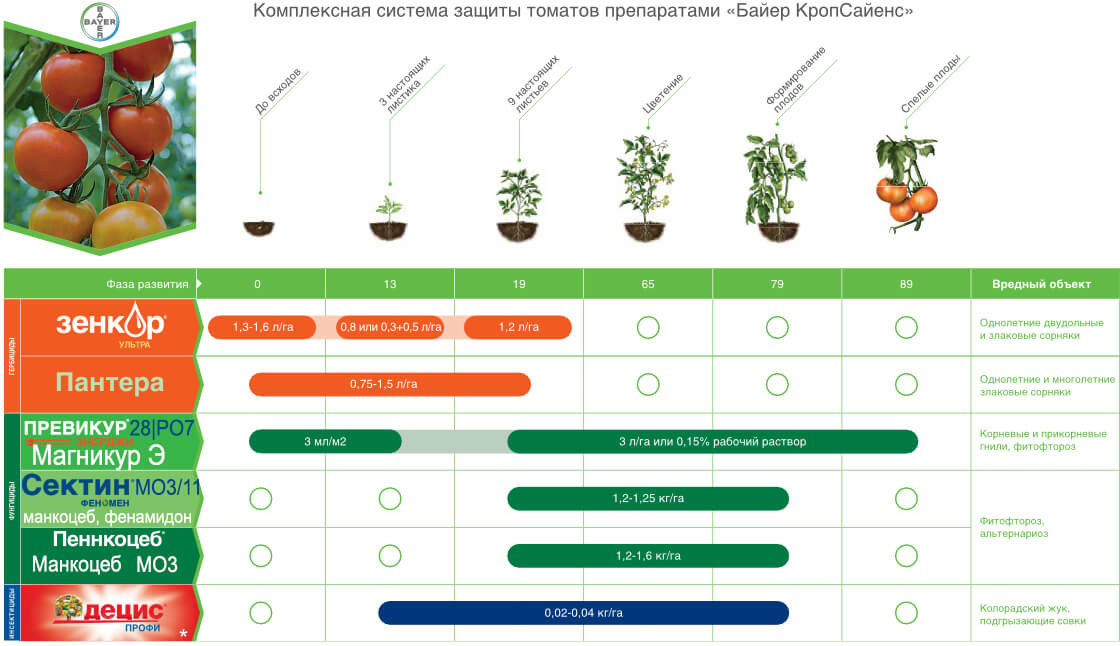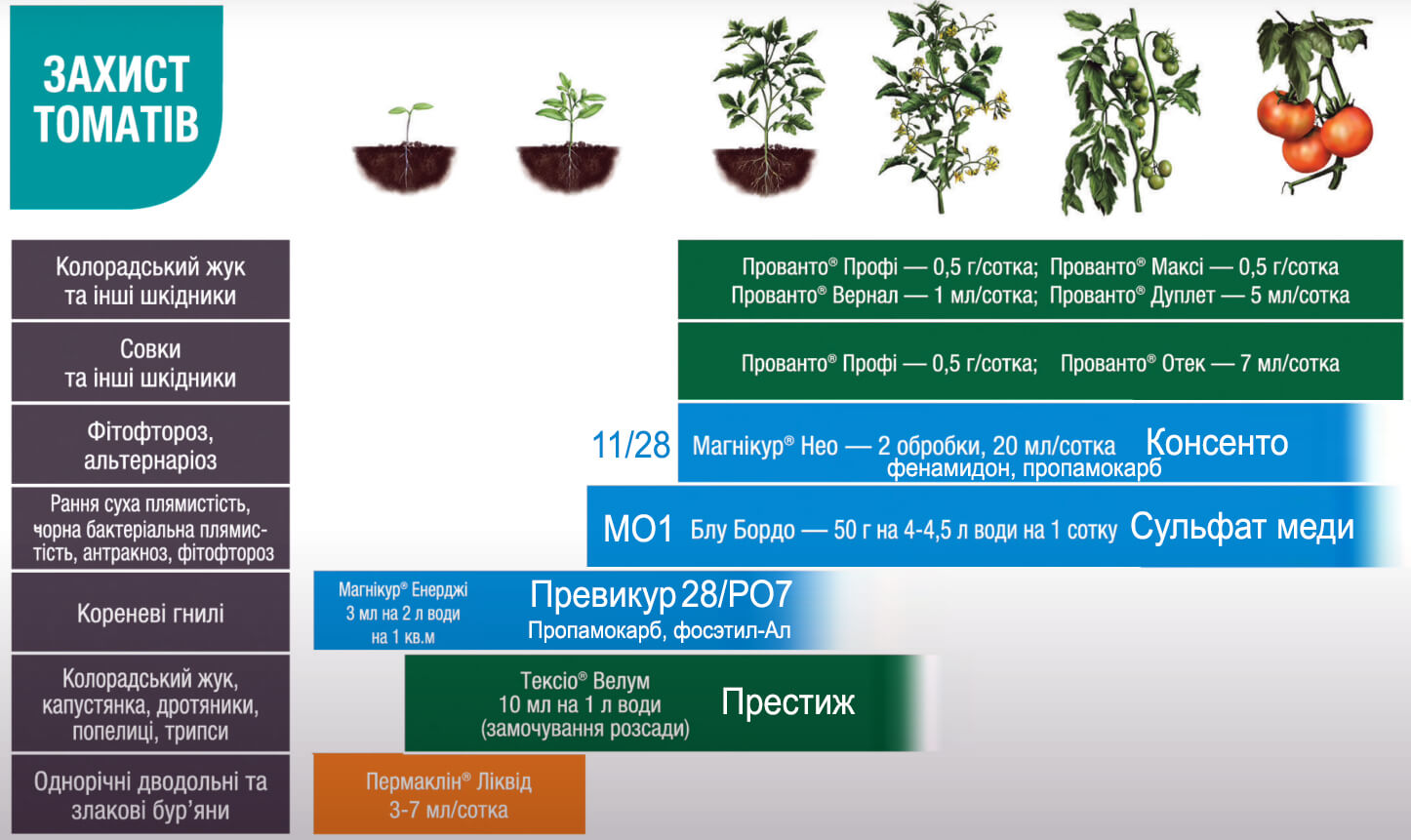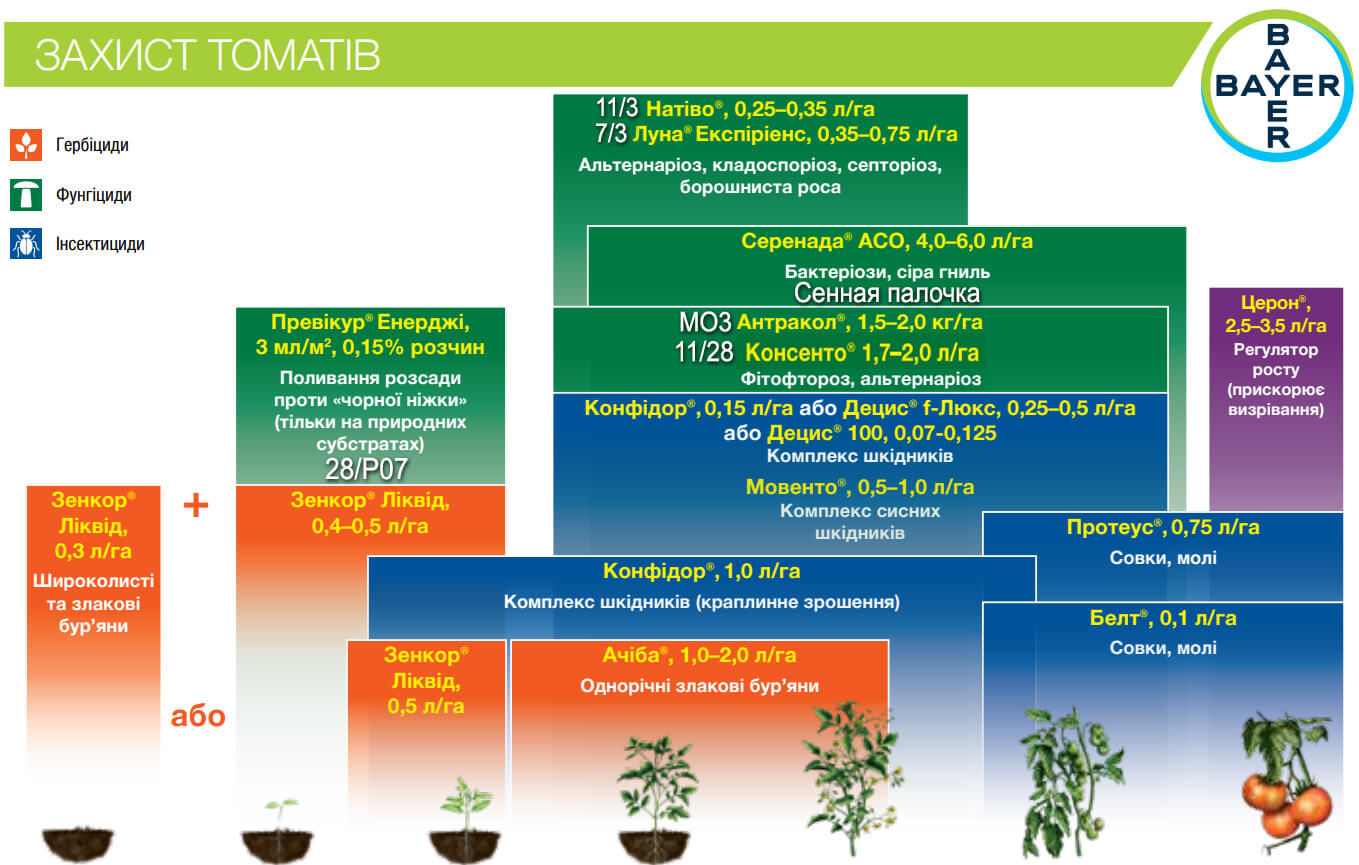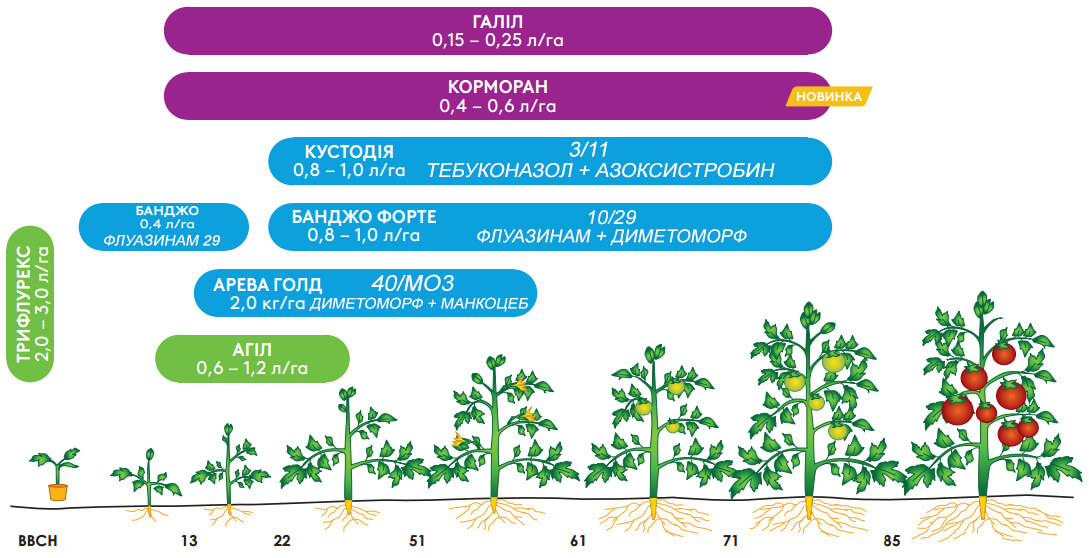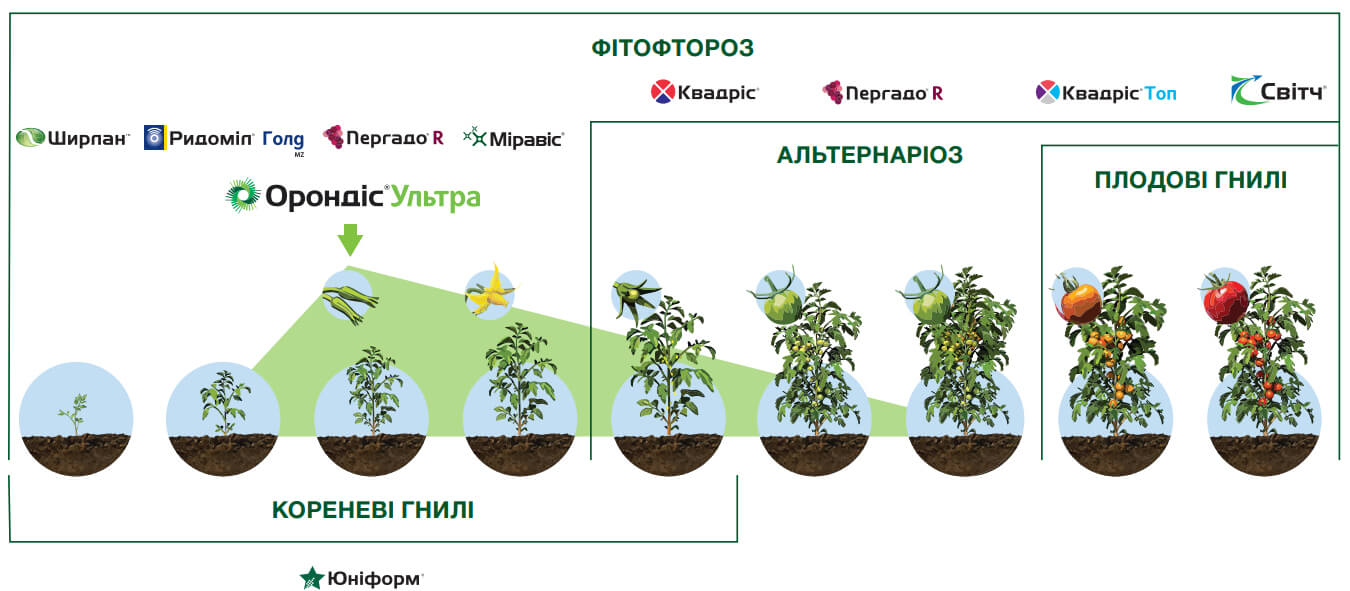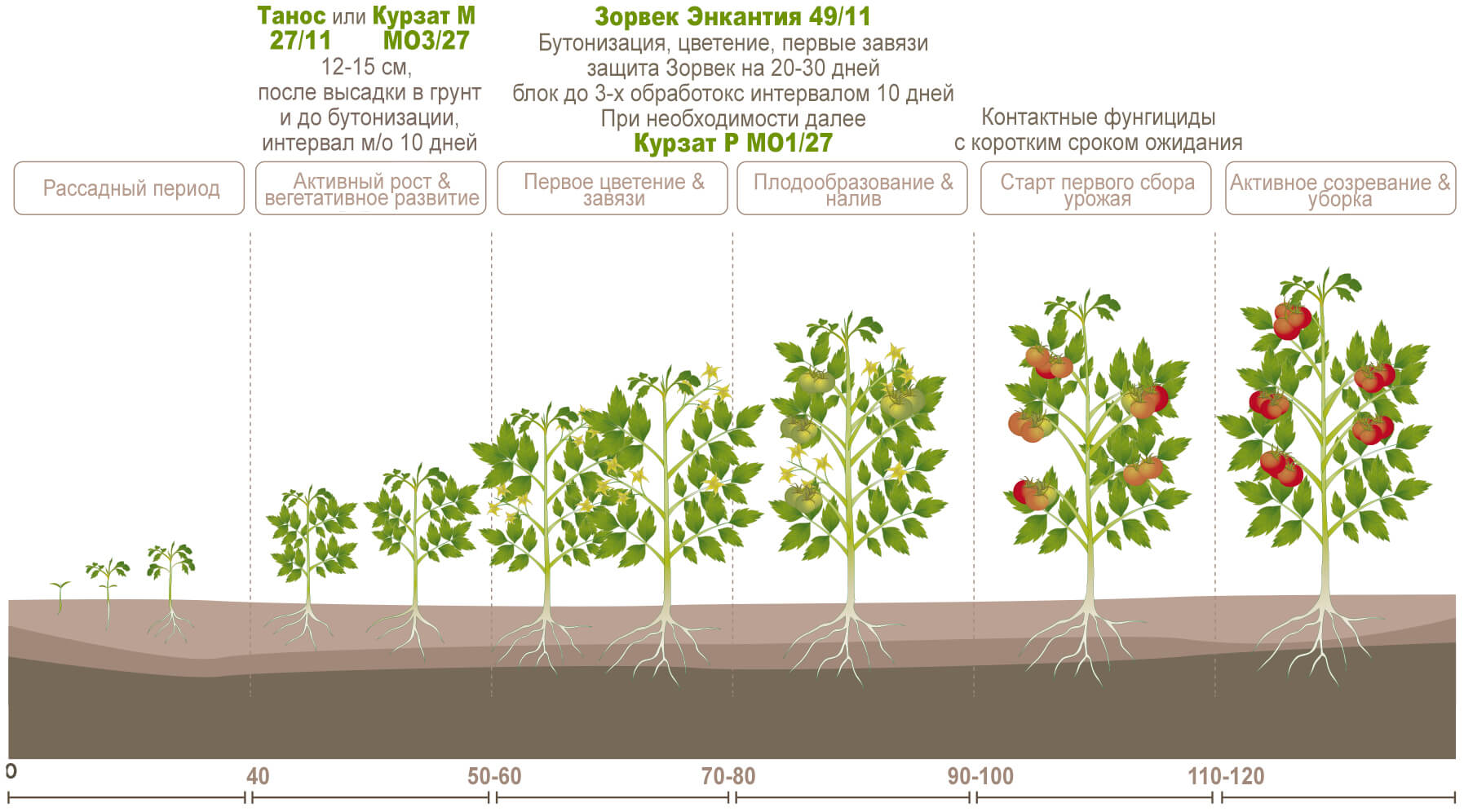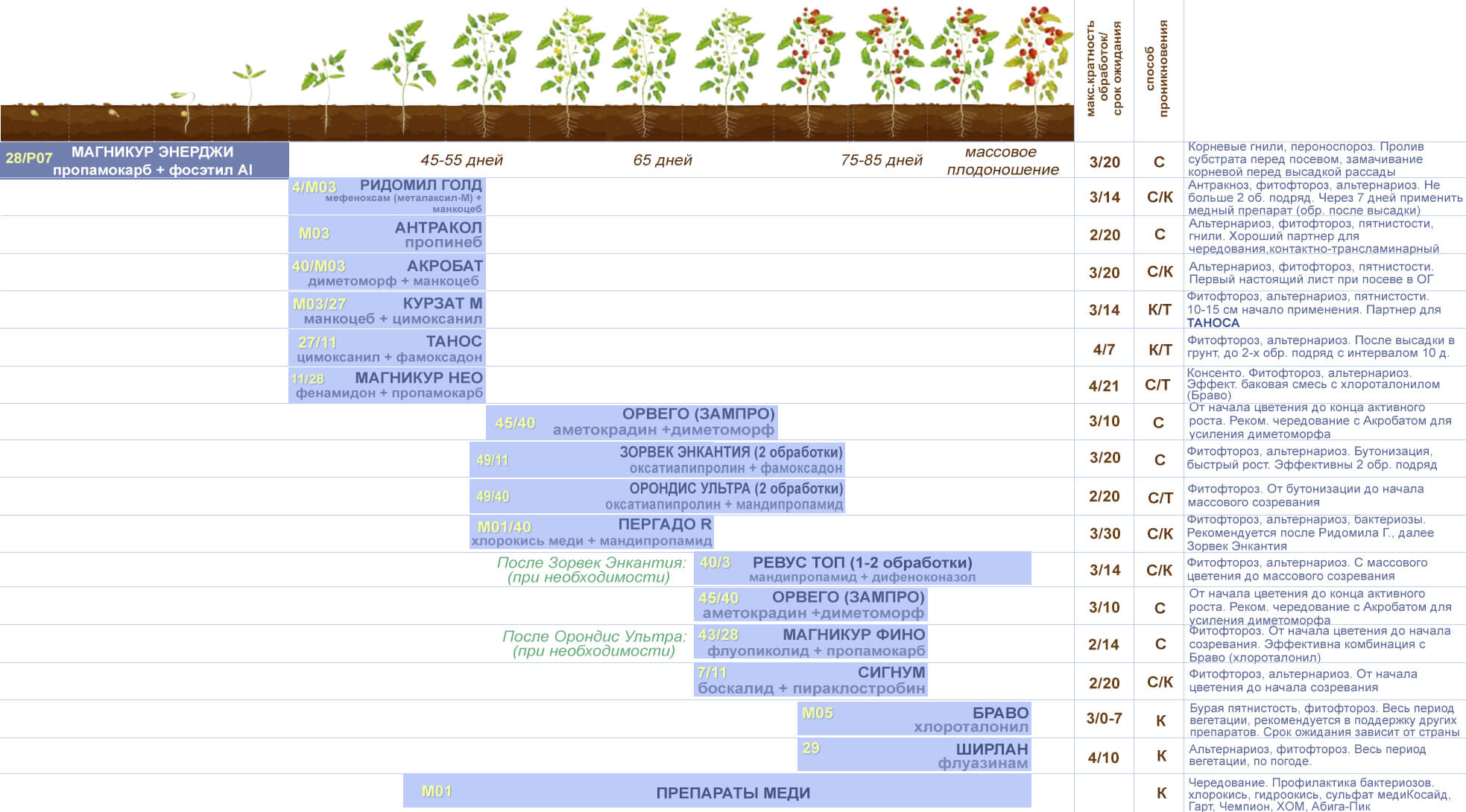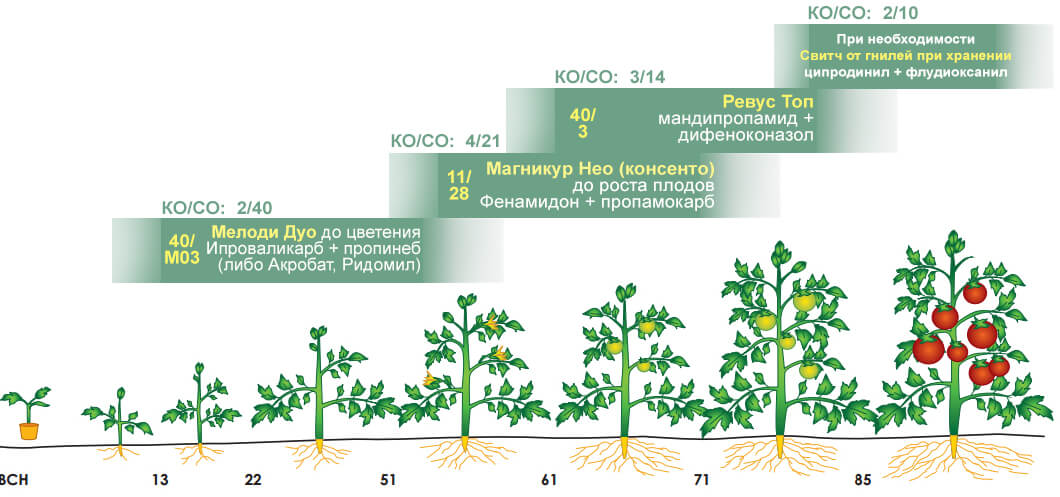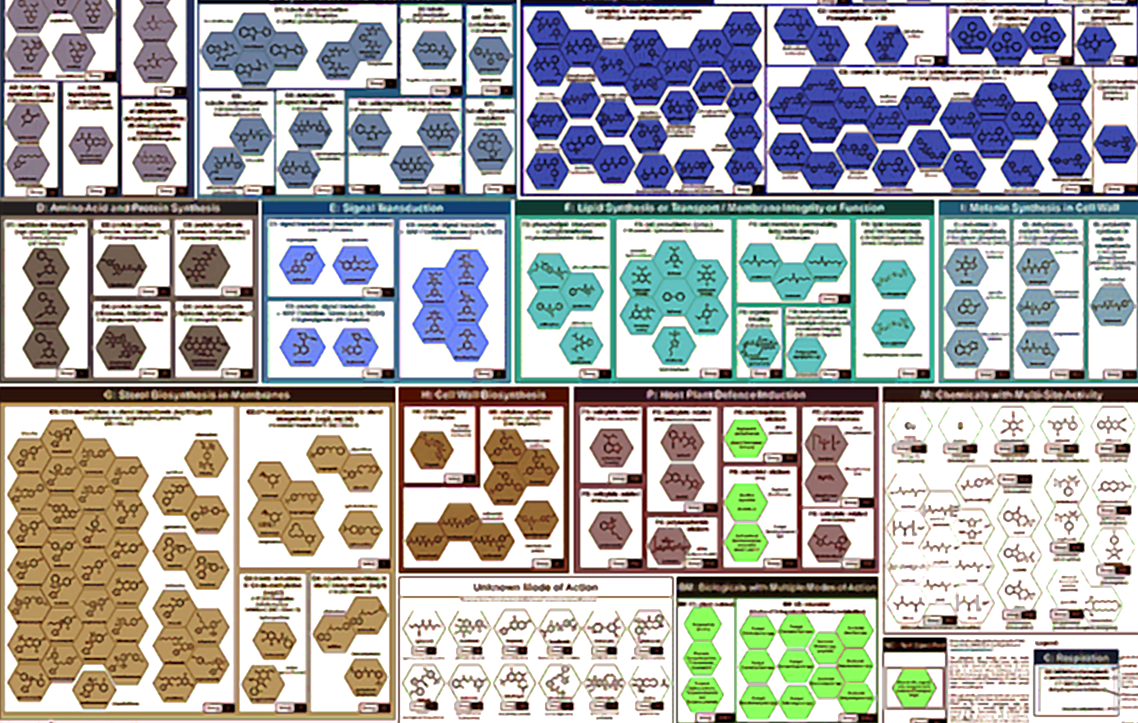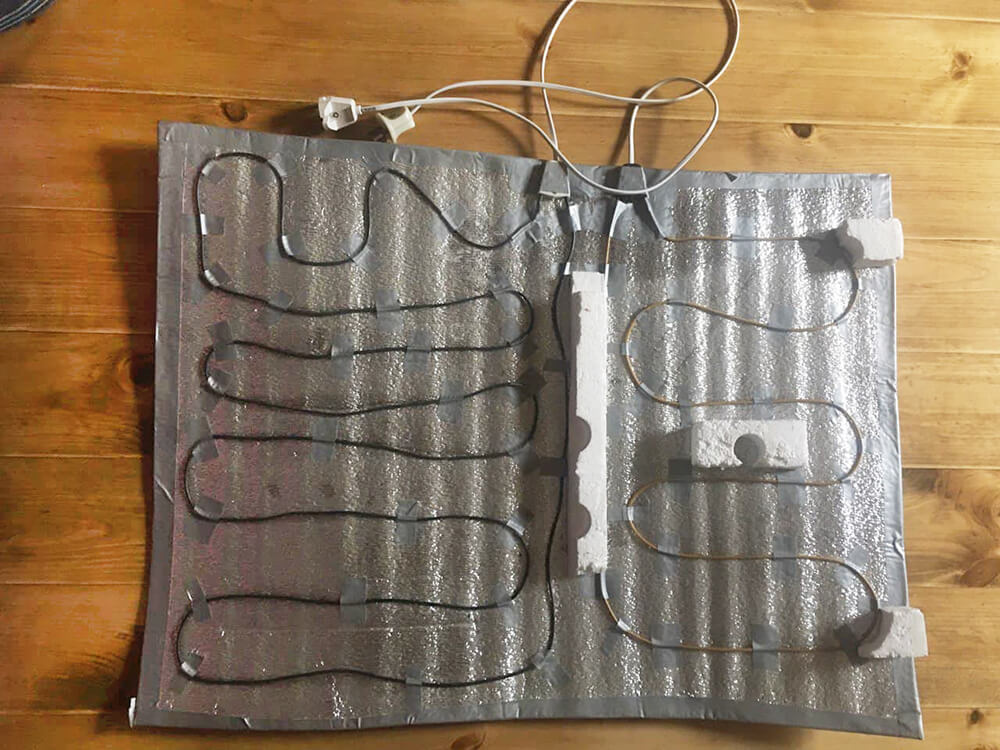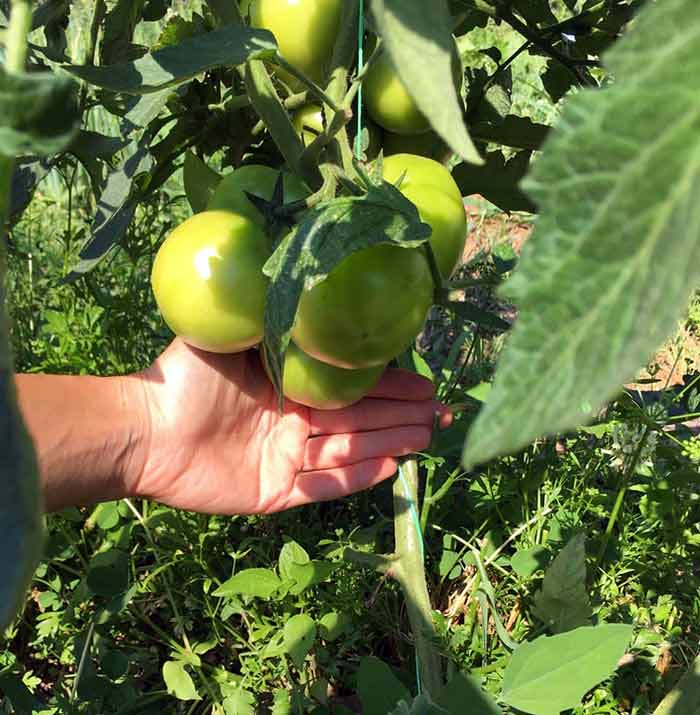I’ve compiled all treatment programs for tomato diseases from leading companies: CORTEVA (a subsidiary of DuPont), Syngenta, Bayer, Protect Garden, BASF, Avgust, Ukravit, and a few good combined schemes from various sources, including my own version. I adjusted them according to FRAC groups (a classification system for pesticides based on cross-resistance and mode of action—more details in the article How to Plan Spraying Schemes for Tomatoes, Potatoes, and Cucumbers Like a Pro ).
Each treatment scheme can and should be modified, substitutions can be made, and tank mixtures prepared. Often, manufacturers don’t have a complete lineup of necessary plant protection products, so we need to develop our own protection strategies based on the availability of products on the market, using generics and with guidance from FRAC (link above).
Below every “factory-made” program, you’ll find my comments and clarifications—please take a look at them.
Tomato Treatment by UKRAVIT
Enerhodar R07+F28 — a full analogue of Previcur Energy, it acts as both a growth stimulator and protection against soil infections. Effective for root drenching and foliar spraying. Seeds can be soaked in an Enerhodar solution before planting, substrate can be drenched, seedlings watered, and sprayed. No more than 5 applications per season. Suppresses root rot and late blight (soil spraying after transplanting seedlings).
Zakhist A4+U27 contains metalaxyl and cymoxanil. This product initiates prevention after planting tomato seedlings in the ground or a day before planting. Follow up with copper-based products after 6-7 days (Ukravit recommends their copper hydroxide product, Hart). Copper is not recommended for use on open flowers.
Tselitel MO3 based on mancozeb and metalaxyl (similar to Ridomil Gold but with a weaker isomer instead of mefenoxam) is used for the prevention of late blight and alternaria, and is toxic to whitefly larvae. It’s an alternative to Zakhist. Also requires follow-up with a contact product from another group (not MO3) no later than 7 days after application. After 10 days, reapply Tselitel or Zakhist.
Samshit G3+C11 — difenoconazole and kresoxim-methyl (Skor + Strobi). Suitable for controlling late blight and alternaria in mid-season, during the plant’s peak growth and fruit development.
New Scheme by Ukravit excludes Enerhodar but introduces two copper-based products — Violis and Hart. If you interpret the product list in the scheme as a sequence of treatments, two copper-based pesticides back-to-back at the start of the vegetation stage seem unusual. It seems more logical to begin with Zakhist and support it with Violis (copper oxychloride MO1) after 6-7 days.
Sinan G3+C11 essentially repeats Samshit — difenoconazole and pyraclostrobin instead of kresoxim-methyl.
Troiset H40+A4+G3 contains dimethomorph (systemic ingredient from Acrobat), metalaxyl, and difenoconazole. Controls and suppresses alternaria, late blight, spots, and macrosphoriosis. Previously known under the trade name Triafit.
Each product in the lineup has its merits, but I would add contact pesticides, especially during the fruit-bearing phase. Additionally, seedlings should have protection against root rot. For this season, I have purchased Strazh (Chorus), Triafit (Troiset), Tselitel, and Enerhodar from Ukravit.
Tomato Protection System by AVGUST
The first preventive treatment can be done with Metaxyl A4+MO3 (metalaxyl + mancozeb) or Ordán MC MO3+U27 (mancozeb + cymoxanil, similar to Kurzat M). Both products should be supported with a copper-based product after 6-7 days — Kumir MO1 (tribasic copper sulfate).
Avgust suggests repeating Metaxyl application before flowering or closing the active growth phase with Ordán.
When the foliage mass is formed, and the tomato starts flowering, Raek G3 (difenoconazole) in tandem with Intrada C11 (azoxystrobin) could be the treatment of choice. This tank mix forms a curative and preventive contact-systemic pesticide during a crucial vegetation phase. Essentially, it’s a combination of Skor + Quadris.
For the fruit-setting stage, I would recommend Raek + Libertador (cyazofamid, the active ingredient in Ranman Top). Libertador has not yet been included in the scheme as it was only recently registered. However, cyazofamid is long known in professional pesticide applications as an exemplary controller of late blight with protection for new growth. Libertador can be used at any stage of vegetation, up to 3 times.
Talent MO5 (Chlorothalonil) and Its Application
Talent MO5 (chlorothalonil) is classified as a 2nd hazard class substance and is not permitted for use everywhere in private households. It is an effective contact fungicide that must be handled with care.
Tomato Treatment by BASF
The latest BASF catalog offers a protection plan consisting of 7 treatments. The 2nd, 4th, and 7th applications include Orvego C45+H40 (ametoctradin + dimethomorph). The 5th and 6th applications use Signum C2/7+C3/11. It is likely that the first and third treatments can be adapted from the older scheme.
Preventative measures can begin with Acrobat H40+MO3 (dimethomorph + mancozeb) or Cabrio Top MO3+C3/11 (metiram + pyraclostrobin).
- Orvego C45+H40 (ametoctradin + dimethomorph);
- Strobi C3/11 (kresoxim-methyl), Polyram MO3 (metiram), Acrobat H40+MO3—one of these to choose from (avoid repeatedly applying treatments from the same FRAC groups consecutively);
- Orvego C45+H40;
- Twice Signum C2/7+C3/11 (boscalid + pyraclostrobin);
- Orvego C45+H40.
I wouldn’t recommend constructing a tomato protection system solely based on BASF products. Incidentally, Konovalyuk, a major farming enterprise in Kherson, published a scheme they used for tomatoes in experimental BASF greenhouses:
- Acrobat H40+MO3
- Polyram MO3
- Cabrio Duo C3/11+H40
- Polyram MO3
- Polyram + Acrobat MO3+H40+MO3 (end of flowering, fruit setting)
- Cabrio Duo C3/11+H40
- Orvego C45+H40
This list can be adjusted to fit an anti-resistance program, as most of the preparations are approved for use 3–5 times.
Tomato Disease Treatment Schedule by Family Garden
Family Garden products, sold in local stores, offer budget-friendly alternatives to branded products. I occasionally buy some items. Overall, their fungicide schemes are weak, though each product can be included in tank mixes.
We have a Ridomil analogue Remontal A4+MO3 (metalaxyl + mancozeb) for the active growth phase until the beginning of flowering, alternating with the contact fungicide Jeep C5/29—an analogue to Shirlan (fluazinam). From the start of flowering to fruit ripening, Salto B1/1 (thiophanate-methyl) is used. Thiophanate-methyl has not been used in Europe since 10.2021 due to low efficacy and its classification as a hazard class 2 substance. It had success against fusarium and cercospora, but pathogens quickly adapt to thiophanates. Stark C3/11 (azoxystrobin), an analogue of Quadris, has some activity against alternariosis but is ineffective against late blight. Like all other strobilurins, azoxystrobin should be used in tank mixes with preparations from other groups.
Tomato Protection by Bayer
Bayer’s protection programs are quite the challenge to navigate. There are several subsidiary companies, where the same product is sold under different trade names. For example, Infinito—Magnicur Fino (Protect Garden Ukraine). Sometimes a product is not approved in a specific country and won’t appear in the program for that crop, whereas in another country it is registered and used (active substances may also be used by other manufacturers for the same crop if they invest in its registration). In short, I am publishing all the latest Bayer schemes I managed to find.
Protect Garden’s scheme is rather sparse, but we can always borrow products from Bayer’s professional series, which have a much more interesting list. There is even a new strain of Bacillus subtilis being proposed for combination use with fungicides. An older leaflet for late blight and alternariosis recommended working exclusively with mancozeb and fenamidone. At the very least, copper-based preparations could be added. Penncozeb is now produced by UPL, a company that spun off from Bayer.
Tomato Treatments by ADAMA
The Israeli company ADAMA registered three fungicides for tomatoes. Current recommendations can be seen in the leaflet above. At the 2017 Field Day, the following scheme was presented:
- 27.06 Banjo C5/29 fluazinam (Shirlan analogue)
- 10.07 Areva Gold H40+MO3 dimethomorph + mancozeb (Acrobat analogue)
- 20.07 Custodia G1/3+C3/11 tebuconazole + azoxystrobin. A debatable choice, pairing azoxystrobin with tebuconazole, which is narrowly specialized for cereal diseases and applying it to tomatoes.
- 27.07 Sphinx Extra H40+MO4 dimethomorph + folpet. Similarly, a questionable tomato treatment, as folpet is toxic to bees (!!) and there is scant data on its effects (not a single mention of action on oomycetes in independent sources was found).
- 03.08 Custodia.
- Plus, three copper-based treatments.
Tomato Protection Systems by Syngenta
Below are two tomato protection strategies from Syngenta—one from 2016 and one from 2021, sourced from the latest catalog.
- Pergado M01+H40 is included in a new scheme for controlling bacterial infections. The appropriateness of using copper and mandipropamid during the seedling period is debatable for me. However, the product information states: “Maximum effectiveness is achieved when Pergado ® R is applied after Ridomil ® Gold SC. The product contains copper, so it is advisable to use it for preventing bacterial diseases in the second half of the growing season or after hail, heavy rains, dust storms, or insect damage.”
0.1. Uniform S3/11+A4 is applied as root irrigation: seedlings in the 2-3 true leaf stage; a second time — at the early budding stage after transplanting seedlings into their permanent location.
- The first treatment 10 days after transplanting the seedlings — Quadris S3/11. Important to note, this refers to seedlings grown in trays with 2-3 true leaves! In this case, Quadris treatment can be conducted 2-3 days before transplanting.
- Ridomil Gold A4+M03 is applied during the active growth phase, 2-3 treatments at intervals of 8-14 days. If the seedlings are older than 45 days, Quadris is usually not recommended — transition directly to Ridomil after the plants establish their roots. I treat prior to transplanting (+ including an insecticide), to avoid losses in the first 2 weeks.
- Beginning of fruiting and halting vegetative growth — Revus Top, 1-2 treatments. The latest recommendation includes Quadris Top (either/or). I think combining Revus with Quadris (azoxystrobin) is sufficient to gain the advantages of both products, provided the weather conditions are appropriate.
About Quadris and other substances in group C: they should be used in alternate seasons as resistance to them develops very quickly. If your products contain substances such as Azoxystrobin, Dimoxystrobin, Kresoxim-methyl, Picarostrobin, Pyraclostrobin, Trifloxystrobin (Zato), Famoxadone, Fluoxastrobin — avoid using them the following year.
- For the ripening period, Quadris C3/11 and Switch D9+E12 are recommended as products with the shortest waiting period. Switch is advised for controlling rots and spotting during storage, making it particularly relevant for greenhouse tomatoes. Shirlan C5/29 has appeared in new recommendations without specific usage comments. Based on Canadian and Russian guidelines, fluazinam is not applied to tomatoes. Interestingly, fluazinam is part of group C but has a low risk of cross-resistance.
For me, Syngenta’s strategy is the most complete (and sometimes excessive) and well-thought-out, but it could be supplemented with root rot protection during the seedling stage by using Previcur instead of Uniform, or by adding copper-based products.
DuPont (Corteva)
A detailed analysis of DuPont’s scheme is available in an article based on FRAC codes, linked at the beginning.
Universal Disease Management Scheme for Tomatoes
In this table, of course, not all possible products and alternative sequential treatments are included. I’ve based it on Zorvec and Orondis — the most modern products for managing and suppressing oomycetes. I built the system around them and selected combinations within the framework of alternating FRAC codes. Considering the allowed number of treatments, the season can be covered with 2-3 products, ensuring copper as a safety net. During severe epiphytotic seasons, tank mixtures with additional contact pesticides (Shirlan, Bravo) can be used.
Quadris and Score are not included in this table; however, their active substances are present in the suggested products. Mixing azoxystrobin and difenoconazole enhances curative effects against late blight.
Protection Strategies Recommended by Experts from the Vinograd.info Forum
Below, I provide several excellent schemes found on the outstanding Ukrainian forum vinograd.info . All the products are widely available and familiar to everyone, with numerous alternatives. A big thank you to all forum members who share their methods.
Abbreviations:
KO — the maximum allowable number of treatments. It’s worth noting that some products work more effectively when applied in a series, such as Zorvec Enicantia, Quadris.
SO — waiting period. A very important parameter, which can vary significantly from country to country. There’s no universal algorithm for determining the safe starting day for harvesting, but you can be confident that the safety factors are always “with a margin.” I rely on the product label or recommendations from Canada’s Ministry of Agriculture (they have excellent catalogs , user-friendly rather than mere registries with numbers and codes).
I will duplicate the treatment sequence in text form.
- Standard treatments during the seedling stage — Previcur R07+F28 (Magnicur Energy? Enerhodar).
Tanos U27+C3/11 + Score G1/3 applied 10 days after transplanting seedlings. In this case, the forum member specified exact scheduled treatment days with maximum intervals. Usually, product efficacy begins to diminish by the 7th day. Manufacturers recommend an interval of 10 days for most pesticides, particularly under conditions conducive to disease development. Modern copper-based products can almost always act as a backup (avoid using them on flowers). Skor G1/3 is a contact-systemic fungicide that works well against alternariosis, treating and protecting plants. It is effective at the first signs of the disease. The interval between treatments is up to 12 days. For tomatoes, it is recommended to use a tank mixture with Quadris or Strobi (azoxystrobin or kresoxim-methyl) to increase pathogen coverage and reduce the risk of resistance development.
During intervals between systemic treatments, copper can be used, thereby extending protection up to 14 days. ADAMA agronomists on Ukrainian tomato fields apply 3 copper-based treatments.
- Melody Duo H40+M03 before flowering, or Ridomil Gold, Acrobat.
- Magnicur Neo (Consento) C3/11+F4/28 from the beginning of flowering to the start of fruit growth.
- Revus Top H40+G1/3 until mass ripening.
- Switch D9+E12 to protect against storage rots and anthracnose.
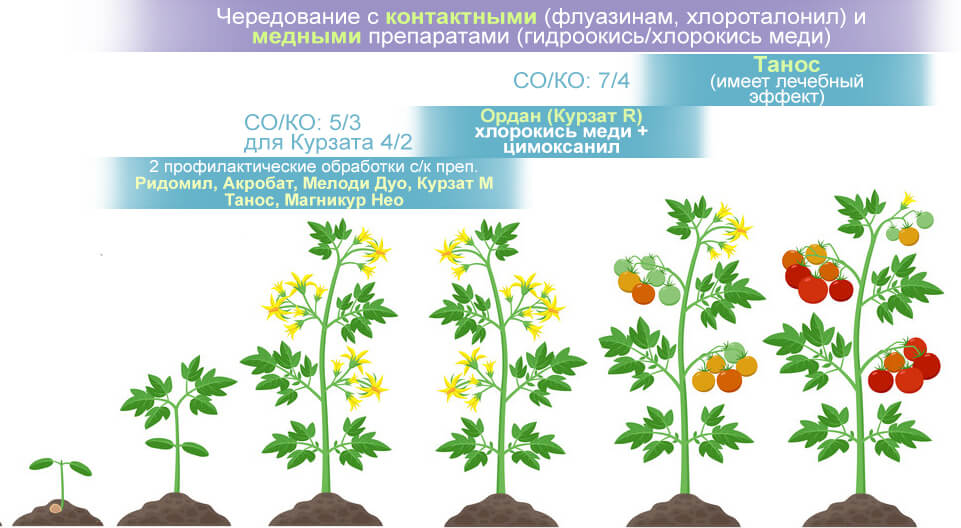 Tomato plant growth stages infographic elements in flat design. Planting process of tomato from seeds sprout to ripe vegetable, plant life cycle isolated on white background, stock vector illustration.
Tomato plant growth stages infographic elements in flat design. Planting process of tomato from seeds sprout to ripe vegetable, plant life cycle isolated on white background, stock vector illustration.
- Two preventive treatments with one of the following products: Ridomil Gold, Acrobat, Melody Duo, Kurzat M, Thanos, Magnicur Neo.
- 1-2 treatments with Ordan or Kurzat R.
- Thanos in case of unfavorable weather and epidemics.
- Alternate with copper and contact agents Bravo and Shirlan (they can be included in tank mixtures).
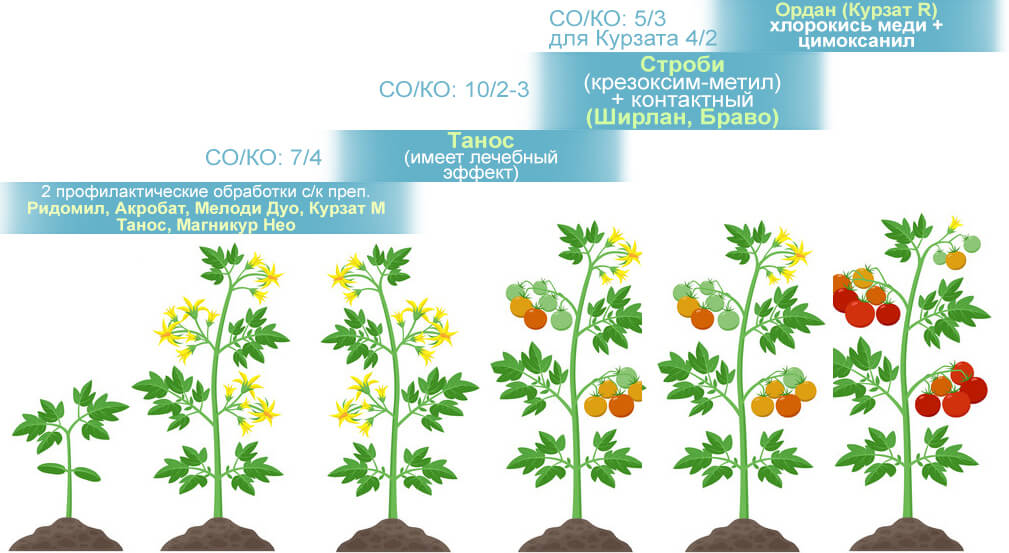 Tomato plant growth stages infographic elements in flat design. Planting process of tomato from seeds sprout to ripe vegetable, plant life cycle isolated on white background, stock vector illustration.
Tomato plant growth stages infographic elements in flat design. Planting process of tomato from seeds sprout to ripe vegetable, plant life cycle isolated on white background, stock vector illustration.
- Two preventive treatments with one of the following products: Ridomil Gold, Acrobat, Melody Duo, Kurzat M, Thanos, Magnicur Neo.
- Thanos
- Strobi + Shirlan or Bravo
- Ordan (Kurzat R)
If you have any questions regarding the schemes or need help decoding the instructions, feel free to ask—I will respond to everyone.
